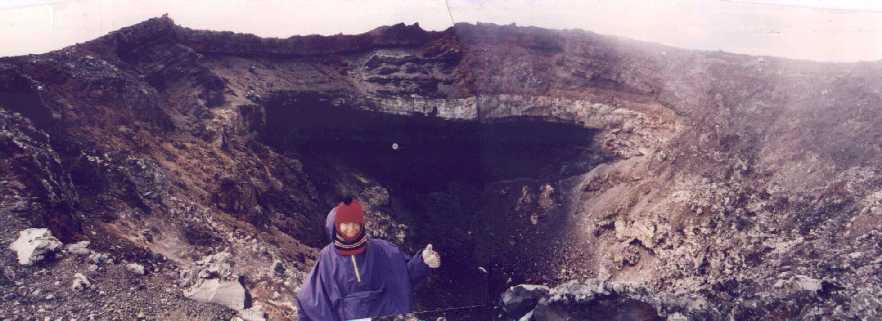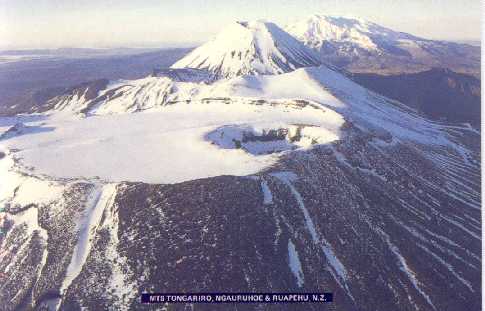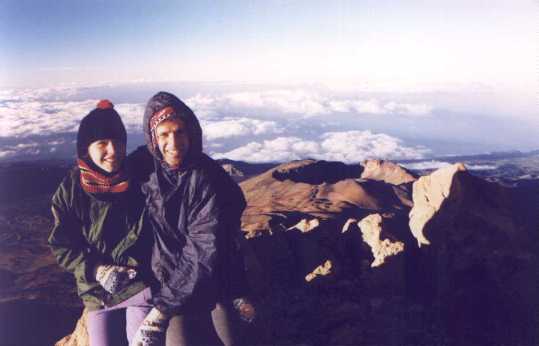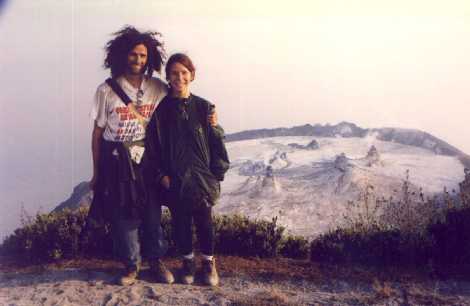Volcanoes of the World - From a Personal Point of View
First contact:
My beloved Talinka and I became fond of volcanoes
in a slow and gradual process. Our "first date" was indeed a
"blind date". In November 1995 we were in Papua New
Guinea, just after exploring the Sepik river, on our way to
Madang town. We looked in the
Lonely Planet guidebook for a stop-over in order to break our long journey.
We read that in Manam island the society is divided into tribes, each
having his own "chief". The book wrote that this structure is unique
to Manam, so we decided to go there.
When in Manam, we couldn't ignore the steaming
Manam volcano which erupted a year prior to our arrival.
Actually, anywhere in the
island one could see the frozen lava rivers which cover the dense
tropical forest. The eruption was so recent, that some of the paths
indicated in the Lonely Planet guide, were covered with lava
and unusable. To our demand, the chief told one of his tribe-men to
show us the volcano. We left in the morning with light snacks and a
liter of water each, not knowing really what to expect. We walked through
the jungle until we reached a frozen river of lava and started to
climb up, to the summit, some 1,800 meters above us. We had no chance
to make it. The walk on the one-year-old lava was very torcherous. It
was like walking on broken glass. Add to that the black colour
which absorbs the heat of the tropical sun and the amount of water we
had, and don't be surprised that we gave up around the third of the way. We
took some panoramic photographs and returned to the village. As we
were pressed with time, we didn't try once more. Still, that first
experience, even though we didn't reach the top, made us motivated and
curious to conquer a peak of an active volcano. |

|
|
On the way to the crater of Manam volcano, 1,807m'. |
Second contact: Three months later we
were in a book shop in the north island of New
Zealand. We looked in a book describing the mountains of this
beautiful country and saw an aerial view of the crater of
Ngauruhoe volcano. We said to ourselves that we must climb it. Easier said than done. Although
Ngauruhoe is less than 500 meters above the surface it was a very
difficult climb. Every step you make upward, you slide down half of
it, since the lava pumice doesn't hold. The whether was very windy and
during big parts of the time we were covered with clouds.
Still, we reached the summit and even had some moments of perfect
visibility.
It was amazing, exhilarating, heavenly beautiful.
From that moment we officially became "volcanoes addicted". |

|
|
An aerial view of Ngauruhoe crater. |

Tali on the summit of Ngauruhoe, 2,291m'.
In the rest of the time we were in New Zealand we continued climbing
some more volcanoes:
|

|
Tongariro
was an easy climb and not so impressing.
|
| An aerial view of Tongariro (foreground), Ngauruhoe (middle) and Ruapehu (background) in the winter. |
Ruapehu is the highest mountain in the north island (2,797 meters
high).
We were surprised to see that there is a ski station on the mountain
which is operating during the winter months !
In the summer, the cable car is serving
the tourists who want to see the crater and the lake covering it.
When we were in the vicinity of Ruapehu the weather was awful. We came
back several days later, when it calmed down a bit.
The cable car was operating only halfway up, because it was still too windy.
We climbed the rest of the way by foot, about two hours of non stop climb.
Unfortunately when we arrived to the summit, it was too cloudy to see
the crater clearly.
Three months later, just one week before the opening of the ski season,
without any prior signs, the mountain erupted, sending the crater
lake to the sky. It was a big miracle. If it had erupted two weeks later,
hundreds of skiers would have died ! |

|
|
An ad for Ruapehu ski station. |
Taranaki (Mt. Egmont) is also known as the Mt. Fuji of New
Zealand. Taranaki, although not the highest amongst the 4 volcanoes
mentioned ("only" 2,518 meters), is the most difficult to climb. The
mountain is not inland, like the other three, but very close to the
sea shore.
This means that the starting point of the climb is almost at sea level.
This also means that the mountain is very exposed to the wind and rain.
We preferred to walk the 3-days "round the mountain" track, and only then, as a "bonus" to climb it.
The weather on first day of the trek was great.
Now we know that it was because we walked in the side of the mountain which
is protected from the wind.
On the second day the weather deteriorated as we progressed encircling the mountain.
On the third day it was so bad (a real storm !) that we quit in the middle.
The nice people of DOC (Department Of Conservation) let us take a hot shower at their place and drove us all the way down to New Plymouth.
We waited several days till the wind eased. Only then we attempted the summit.
It is possible to climb the summit in one long day.
We decided to break it into two days.
On the first day we climbed only until the parasite cone, Fanthams Peak, which was formed by a side vent of the volcano.
It is about 600 meters below the main crater, where new Syme hut (only 8 beds inside!) is located.
Not surprisingly the hut was deserted and we had it to ourselves.
Obviously the sun set was very romantic...
The sun rise was very interesting - the clouds were all below us and we could see in the horizon Ngauruhoe, Tongariro and Ruapehu volcanoes, more than 100 Km. away...
After two hours of non-stop climb on the torcherous pumice we conquered the summit.
We were quite surprised to see that we were not the first ones on the summit today.
A (crazy ?) couple pitched a tent on the summit and spent there the night.
On our way down we saw the day trekkers walking their way up... |

|
|
In the foreground is the parasite cone, Fanthams Peak (1,966m'), half covered with clouds. In the background is the main cone, at 2,518m'. |

Tali on the parasite cone of Taranaki. On the left is the main cone, some 600m' heigher. On the right, New Syme hut we slept in.
|

|
On our way back to Israel, on February, we had 10 days stop over in Hawaii.
We couldn't climb either of Mauna Kea and Mauna Loa because they were both covered with snow at that time. Instead we had a close view at the caldera of Kilauea which is the youngest and most active volcano in Hawaii.
|
| A frozen lava flow blocking a road in Hawaii. |
Third contact: Half a year later we
were on the island of Santorini in Greece.
Interestingly, the tickets to Greece we got from the frequent flyer program...
Santorini is justifiably a very touristic place. The reason why I mention it here is that the island is a part of the crater rim of a huge volcano which erupted for the last time some 3,650 years ago.
Since then the volcano sank into the sea, and only a small part of it remained above sea level.

The crater rim of Santorini. The crater itself is in the middle, covered by the sea.
Now we're already 100% hooked on volcanoes. In every place we go, we check first what interesting volcanoes it has to offer...
South America: In the summer of 1997 Tali and I flew to South America.
This time we planned in advance to attempt climbing volcan Parinacota at 6,348m', in Chile (we had great adventures there...). |

|
|
The twin volcanoes "Payachatas". The higher is Volcan Parinacota, 6,348m'. |
|

|
We also climbed volcan Ubinas in Peru (You will not believe what happened to us there...).
|
| On our way to conquer Ubinas peak at 5,672m'. |

The summit of Volcan El Misti, 5,912m'.
|

|
The last volcanoes we visited in South America were
the Galapagos Islands, in Ecuador (we had some peculiar adventures there...).
|
| Tali and I on Bartolome island, one of the Galapagos islands. |
Africa: In the summer of 1998 Tali and I chose to visit Africa.
We planned in advance only the first half of our 3 months trip. We climbed the extinct volcano Mt. Elgon, 4,321m' in Uganda (it was a nice climb), and the extinct volcano Mt. Kenya at 5,200m', in Kenya (we had great adventures there...). |

|
|
Mt. Kenya, as seen from Point Lenana, 4,985m'. |
|

|
We were surprised to discover that our next destination, Tanzania, is practically a volcanoes "play-ground". We rushed to climb the dormant volcano Mt. Meru
(we had wonderful views there...).
|
| Meru summit (4,565m') as seen from Little Meru. |
One month later, we flew to Tenerife in the Canary islands. Unlike the normal tourists we didn't stay at the huge resorts on the beaches, but climbed the very impressive El Teide volcano at 3,715m'.
|

|

|
| Tali and I on the peak of volcan El Teide. On the background is Pico Viejo, the old crater.
|
An aerial view of the El Teide peak, 3,715m'. |
|

|
Iceland: In the summer of 1999 we went to Iceland. It is a cold place which is building up due to numerous and frequent volcanic eruptions. This combination of Ice and Fire attracted us a lot. We climbed the tiny (in height (279m'), not in volcanic record !) Eldfell volcano. While walking the Landmannalaugar to Skogar trek we had fine views of the 1,491m' high Hekla volcano.
|
| October 1973. Eldfell volcano is erupting. |
Italy: In February 2002 Tali and I went to a "volcano tour" in south Italy. I must admit that it was a long time dream of mine. The volcanoes of south Italy are the closest active volcanoes to our home country, Israel, and yet we didn't visit them until that year. We first went to explore the 1,281m' high Vesuvius volcano. This was the best value "volcano" for "effort" we've seen. The crater is a merely 20 minutes walk from the car park, and only 100 meters higher !

On the crater rim of Vesuvius, 1,281m'.
We then took the overnight ferry from Napoli to Stromboli island. This is a classic volcano island. The 900m' high volcano occupies all of the island and leaves a very narrow strip of sea shore. We climbed the volcano in the afternoon, in a thought of staying up until full dark, when the explosions are seen red. Reaching the summit, we heard a huge noise, and felt the ground shaking below our feet. "That's it", we thought, "we are about to be hurt by a violent explosion !". We took a shelter behind a big rock, and saw the mountain emitting lava pumice. Luckily the wind wasn't in our direction... Later on we observed that that eruption occurred every 15 minutes or so. In the night there were red eruptions, but unfortunately it was mostly obscured by the emissions of smoke. |

|
|
Stromboli is a classic "volcano island". |

On the crater rim of Stromboli, 1,281m'. Tali is the small spot slightly right of the right summit.
|

|
We went down using our torchlight and took the 7 a.m. fast hovercraft to our next destination, Vulcan. This mountain is called after the Greek god of hell, Vulcan, which is believed to live inside this volcano. This mountain name is the origion of the English word "volcano", describing any volcano in general...
Although Vulcan is only 500 meters hight, it is quite an interesting volcano: it's very colorful, steaming with fumaroles and the view from the summit to the neighboring islands is exhilarating.
|
| Vulcan: the view from the summit to the neighboring islands is exhilarating. |
Our last volcano in that trip is the 3,350 meters high Mount Etna. In the time of year we visited there it was more appropriate to ski than hike to the top. Nevertheless, we tried to walk to the top, but due to bad weather we were forced to return. |

|
|
In the time of year we visited there it was more appropriate to ski than to hike... |
[ Homepage ]
Last modified: Sat Jun 30th 13:03:08 IST 2001
























